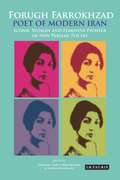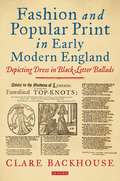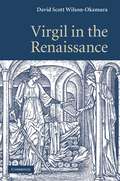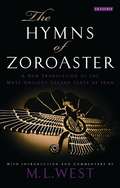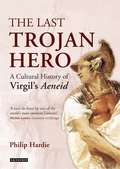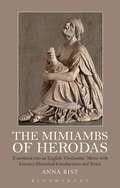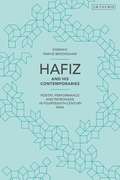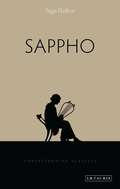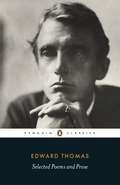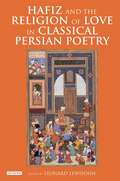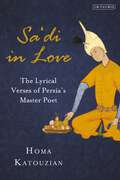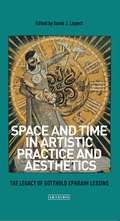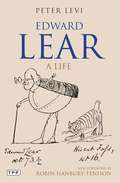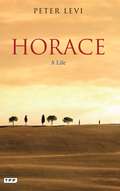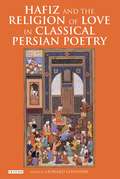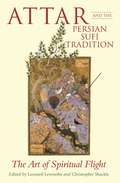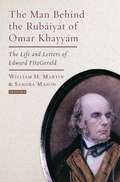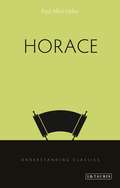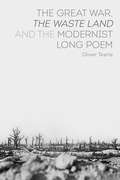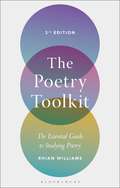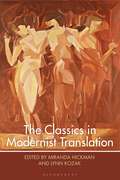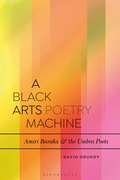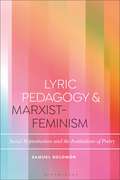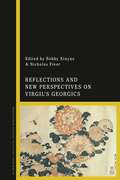- Table View
- List View
Forugh Farrokhzad, Poet of Modern Iran: Iconic Woman and Feminine Pioneer of New Persian Poetry
by Dominic Parviz Brookshaw Nasrin RahimiehThe pioneering Iranian poet and filmmaker Forugh Farrokhzad was an iconic figure in her own day and has come to represent the spirit of revolt against patriarchal and cultural norms in 1960s Iran. Four decades after her tragic death at the age of 32, Forugh Farrokhzad, Poet of Modern Iran brings her ground-breaking work into new focus. During her lifetime Farrokhzad embodied the vexed predicament of the contemporary Iranian woman, at once subjected to long-held traditional practices and influenced by newly introduced modern social sensibilities. Highlighting her literary and cinematic innovation, this volume examines the unique place Farrokhzad occupies in Iran, both among modern Persian poets in general and as an Iranian woman writer in particular. The authors also explore Farrokhzad's appeal outside Iran in the Iranian diasporic imagination and through the numerous translations of her poetry into English. It is a fitting and authoritative tribute to the work of a remarkable woman which will introduce and explain her legacy for a 21st-century audience.
Fashion and Popular Print in Early Modern England: Depicting Dress in Black-Letter Ballads
by Clare BackhouseFashion featured in black-letter broadside ballads over a hundred years before fashion magazines appeared in England. In the seventeenth century, these single-sheet prints contained rhyming song texts and woodcut pictures, accessible to almost everyone in the country. Dress was a popular subject for ballads, as well as being a commodity with close material and cultural connections to them.This book analyses how the distinctive words and images of these ballads made meaning, both in relation to each other on the ballad sheet and in response to contemporary national events, sumptuary legislation, religious practice, economic theory, the visual arts and literature. In this context, Clare Backhouse argues, seventeenth-century ballads increasingly celebrated the proliferation of print and fashionable dress, envisioning new roles for men and women in terms of fashion consumption and its importance to national prosperity. The book demonstrates how the hitherto overlooked but extensive source material that these ballads offer can enrich the histories of dress, art and culture in early modern England.
Virgil in the Renaissance (PDF)
by David Scott Wilson-OkamuraThe disciplines of classical scholarship were established in their modern form between 1300 and 1600, and Virgil was a test case for many of them. This book is concerned with what became of Virgil in this period, how he was understood, and how his poems were recycled. What did readers assume about Virgil in the long decades between Dante and Sidney, Petrarch and Spenser, Boccaccio and Ariosto? Which commentators had the most influence? What story, if any, was Virgil’s Eclogues supposed to tell? What was the status of his Georgics? Which parts of his epic attracted the most imitators? Building on specialized scholarship of the last hundred years, this book provides a panoramic synthesis of what scholars and poets from across Europe believed they could know about Virgil’s life and poetry.
The Hymns of Zoroaster: A New Translation of the Most Ancient Sacred Texts of Iran
by M. L. WestA new translation of the foundation texts of the Zoroastrian religion, the Gathas (songs) composed by Zoraster himself, together with the Liturgy in seven chapters composed shortly after his death some 2600 years ago. After a substantial introduction to Zoroaster's religious thought, West presents the translations with facing page explanations of the meaning of each verse.
The Last Trojan Hero: A Cultural History of Virgil's Aeneid
by Philip HardieThe resonant opening lines of Virgil's Aeneid rank among the most famous and consistently recited verses to have been passed down to later ages by antiquity. And after The Odyssey and the Iliad, Virgil's masterpiece is arguably the greatest classical text in the whole of Western literature. This sinuous and richly characterised epic vitally influenced th poetry of Dante, Petrarch and Milton. The doomed love of Dido and Aeneas inspired Purcell, while for T.S. Eliot Virgil's poem was 'the classic of all Europe'. The poet's stirring tale of a refugee Trojan prince, 'torn from Libyan waves' to found a new homeland in Italy, has provided much fertile material for writings on colonialism and for discourses of ethic and national identity. The Aeneid has even been viewed as a template and source of justification for British and European imperialisms and for American nation-building. In his major and much anticipated new book Philip Hardie explores the many remarkable afterlives- ancient, medieval and modern- of the Aeneid in literature, music, politics, the visual arts and film.The Last Trojan Hero, by one of Virgil's leading interpreters, put continually fresh and surprising perspectives on one of the outstanding works of civilization. Placing the Aeneid on a broad artistic and historical canvas, it shows with elegance, originality and creative insight how and in what ways this remarkably durable text continues so powerfully to capture the cultural imagination and why it still speaks to us over a gulf of centuries.
The Mimiambs of Herodas: Translated into an English ‘Choliambic’ Metre with Literary-Historical Introductions and Notes
by Anna RistThe third-century BC Greek poet Herodas had been all but forgotten until a papyrus of eight of his Mimiambs (plus fragments) turned up in the Egyptian desert at the end of the 19th century. They have since been translated into various modern languages and supplied with scholarly commentaries. This book is the first to attempt to reproduce in English Herodas' 'choliambic' or 'limping' metre (sic) - distinctive for its signatory reversed final foot, a variant on the standard Greek iambic trimeter. The present volume provides an accessible introduction to Herodas and his Mimiambs requiring no knowledge of Greek. The translation steers a judicious course between literal accuracy and fidelity to this linguistically very demanding poet's spirit and intention. The contextual introductions and notes on the poems take into account the most recent scholarship, providing explanation of the context of the Mimiambs and guiding the reader to an appreciation of the poetry itself. The General Introduction places the author in his cultural world and context, namely urban society in the Ptolemaic Empire of the hellenistic period. This he conjures up in his Mimiambs with an often scathing vividness.
Hafiz and His Contemporaries: Poetry, Performance and Patronage in Fourteenth Century Iran
by Dominic Parviz BrookshawDespite his towering presence in premodern Persian letters, Shams al-Din Muhammad Hafiz of Shiraz (d. 1390) remains an elusive and opaque character for many. In order to look behind the hyperbole that surrounds Hafiz's poetry and penetrate the quasi-hagiographical film that obscures the poet himself, this book attempts a contextualisation of Hafiz that is at once socio-political, historical, and literary. Here, Hafiz's ghazals (short, monorhyme, broadly amorous lyric poems) are read comparatively against similar texts composed by his less-studied rivals in the hyper competitive, imitative, and profoundly intertextual environment of fourteenth-century Shiraz. By bringing Hafiz's lyric poetry into productive, detailed dialogue with that of the counterhegemonic satirist, 'Ubayd Zakani (d. 1371), and the marginalised Jahan-Malik Khatun (d. after 1391; the most prolific female poet of premodern Iran), our received understanding of this most iconic of stages in the development of the Persian ghazal is disrupted, and new avenues for literary exploration open up. Looking beyond the particular milieu of Shiraz, this study re-assesses Hafiz's place in the Persian poetic canon through reading his poems alongside those produced by professional poets in other major centres of Persian literary activity who enjoyed comparable fame in the fourteenth century. Recognising the aesthetic achievements of his contemporaries does not diminish the splendour of Hafiz's, rather it forces us to accept that Hafiz was but one member of a band of poets who jostled for the limelight in competing, often intersecting, patronage and reception networks that facilitated intense cultural exchange between the cities of post-Mongol Iran and Iraq. Hafiz's ghazals, characterised as they are by conscious and deliberate hybridity, ambiguity, and polysemy, are products of a creative mind bent on experimenting with genre. While in no way seeking to deny the mystical stratum of the Persian ghazal in its fourteenth-century manifestation, this study emphasises the courtly and profane dimensions of the form, and regards Hafiz through a sober lens with keen attention to his dynamic role at the heart of a vibrant poetic community that was at once both fiercely local and boldly cosmopolitan.
Sappho (Understanding Classics)
by Page DuBoisSappho has been constructed as many things: proto-feminist, lesbian icon and even – by the Victorians – chaste headmistress of a girls' finishing school. Yet ironically, as Page DuBois shows, the historical poet herself remains elusive. We know that Sappho's contemporary Alcaeus described her as 'violet, pure, honey-smiling Sappho'; and that the rhetorician and philosopher Maximus of Tyre saw her, perhaps less enthusiastically, as 'small and dark'. We also know that her 7th/6th century BCE island of Lesbos was riven by tyrannical and aristocratic factionalism and that she was probably exiled to Sicily. Much of the rest is speculative. DuBois suggests that the value of Sappho lies elsewhere: in her remarkable verse, and in the poet's reception
Hafiz and His Contemporaries: Poetry, Performance and Patronage in Fourteenth Century Iran (British Institute Of Persian Studies Ser. #Vol. 3)
by Dominic Parviz BrookshawDespite his towering presence in premodern Persian letters, Shams al-Din Muhammad Hafiz of Shiraz (d. 1390) remains an elusive and opaque character for many. In order to look behind the hyperbole that surrounds Hafiz's poetry and penetrate the quasi-hagiographical film that obscures the poet himself, this book attempts a contextualisation of Hafiz that is at once socio-political, historical, and literary. Here, Hafiz's ghazals (short, monorhyme, broadly amorous lyric poems) are read comparatively against similar texts composed by his less-studied rivals in the hyper competitive, imitative, and profoundly intertextual environment of fourteenth-century Shiraz. By bringing Hafiz's lyric poetry into productive, detailed dialogue with that of the counterhegemonic satirist, 'Ubayd Zakani (d. 1371), and the marginalised Jahan-Malik Khatun (d. after 1391; the most prolific female poet of premodern Iran), our received understanding of this most iconic of stages in the development of the Persian ghazal is disrupted, and new avenues for literary exploration open up. Looking beyond the particular milieu of Shiraz, this study re-assesses Hafiz's place in the Persian poetic canon through reading his poems alongside those produced by professional poets in other major centres of Persian literary activity who enjoyed comparable fame in the fourteenth century. Recognising the aesthetic achievements of his contemporaries does not diminish the splendour of Hafiz's, rather it forces us to accept that Hafiz was but one member of a band of poets who jostled for the limelight in competing, often intersecting, patronage and reception networks that facilitated intense cultural exchange between the cities of post-Mongol Iran and Iraq. Hafiz's ghazals, characterised as they are by conscious and deliberate hybridity, ambiguity, and polysemy, are products of a creative mind bent on experimenting with genre. While in no way seeking to deny the mystical stratum of the Persian ghazal in its fourteenth-century manifestation, this study emphasises the courtly and profane dimensions of the form, and regards Hafiz through a sober lens with keen attention to his dynamic role at the heart of a vibrant poetic community that was at once both fiercely local and boldly cosmopolitan.
Selected Poems and Prose (English Library)
by Edward Thomas'I have come to the borders of sleep, The unfathomable deepForest where all must loseTheir way, however straight,Or winding, soon or late;They cannot choose.' Fired by his abiding love of the English landscape, the poetry of Edward Thomas is some of the most astonishing of the twentieth century. A journalist, essayist and critic for many years, he was encouraged to write verse by his friend Robert Frost. He produced a late outburst of poetry of extraordinary beauty and mystery about the subjects closest to his heart: rural England and its inhabitants, landscape, atmosphere, transience, endurance and death. By 1917, when he was killed on the Western Front, he had earned his place as one of England's most valued poets. This selection brings together his finest verse with his most vivid prose writings on the countryside.
Hafiz and the Religion of Love in Classical Persian Poetry
by Leonard LewisohnI.B.Tauris in association with the Iran Heritage Foundation
Sa'di in Love: The Lyrical Verses of Persia's Master Poet (International Library of Iranian Studies)
by Homa KatouzianWith poetry which speaks across the ages, Sa'di (1210–81) is a vital classical poet and a towering figure of the medieval Persian canon. Comparable in skill and stature to other Persian poets such as Ferdowsi, Hafez, Rumi and Omar Khayyam, Sa'di's verses – best known through his 'Bustan' and 'Golestan' – address universal themes of passion, love and the human condition in works which are both psychologically perceptive and beautifully crafted. His mystical writings, contemporaneous with Rumi, reveal a degree of depth, wisdom and insight which have placed Sa'di in the pantheon of world literature. In this essential new translation of Sa'di's work, leading expert on Iranian studies Homa Katouzian seeks to bring the poet's lyrics to a new readership. The book provides the Persian text and Katouzian's English translation side-by-side, creating an indispensible tool for students and enthusiasts of Iranian history, literature and culture.
Space and Time in Artistic Practice and Aesthetics: The Legacy of Gotthold Ephraim Lessing (International Library of Modern and Contemporary Art)
by Sarah LippertWhen the Enlightenment thinker Gotthold Ephraim Lessing wrote his treatise Laocoön: An Essay on the Limits of Painting and Poetry in 1766, he outlined the strengths and weaknesses of each art. Painting was assigned to the realm of space; poetry to the realm of time. Space and Time in Artistic Practice and Aesthetics explores how artists since the eighteenth century up to the present day have grappled with the consequences of Lessing's theory and those that it spawned. As the book reveals, many artists have been - and continue to be – influenced by Lessing-like theories, which have percolated into the art education and art criticism. Artists from Jean Raoux to Willem de Kooning and Frances Bacon, and art critics such as Clement Greenberg, have felt the weight of Lessing's theories in their modes of creation, whether consciously or not. Should we sound the death knell for the theories of Lessing and his kind? Or will conceptions of temporality, spatiality and artistic competition continue to unfold? This book - the first to consider how Lessing's writings connect to visual art's production - brings these questions to the fore.
Edward Lear: A Life
by Peter Levi"Children swarmed to him like settlers. He became a land." W.H. AudenEdward Lear - beloved nonsense poet, author of such adored poems as The Owl and the Pussycat, inventor of otherworldly characters like Quangle-Wangles and of the modern limerick; lauded artist and illustrator - was a genius who defies classification. Gregarious and popular, Lear had a wide circle of friends, but was often lonely and subject to frequent bouts of depression and debilitating epilepsy, the shame of which he struggled with all his life. In this captivating biography, fellow poet Peter Levi renders descriptions of Lear's sketches and watercolours (of which he painted some 10,000 in the course of his career) and provides incisive portraits of his classic poems, such as The Jumblies, The Owl and the Pussycat and The Yonghy-Bonghy-Bo, setting them in the wider context of traditional nursery rhymes. Lear belonged to the great tradition of adventurous British travellers, undertaking extensive journeys in Italy and Greece, in Albania, Turkey, Egypt, Palestine and India and these always-eventful journeys are related here, alongside extracts and quotations from his letters and diaries - an essential biography for all lovers of this remarkable British literary figure and now recognised as one of the greatest 19th century landscape painters.
Horace: A Life
by Peter LeviThe work of the great Roman poet, Horatius Flaccus (65 BC to 8 BC), spanned all aspects of Roman life: politics, the arts, religion, and the authority of the emperor, while his legendary poems (Satires, Odes, Epistles) about friendship, philosophy, love and sex still have widespread appeal. This biography attempts to present a complete picture of Horace's life and world. It considers the details of Horace's romantic liaisons and why he never married, what the status of his father - a freed man - meant to the poet, and his distinctive brand of philosophy. In this acclaimed biography, Peter Levi - a fellow poet - has produced a thrilling and eminently readable book, the definitive on Rome's greatest poet and the times during which he lived.
Hafiz and the Religion of Love in Classical Persian Poetry (International Library of Iranian Studies)
by Leonard LewisohnThe romantic lyricism of the great Persian poet Hafiz (1315-1390) continues to be admired around the world. Recent exploration of that lyricism by Iranian scholars has revealed that, in addition to his masterful use of poetic devices, Hafiz's verse is deeply steeped in the philosophy and symbolism of Persian love mysticism. This innovative volume discusses the aesthetic theories and mystical philosophy of the classical Persian love-lyric (ghazal) as particularly exemplified by Hafiz (who, along with Rumi and Sa'di, is Persia's most celebrated poet). For the first time in western literature, Hafiz's rhetoric of romance is situated within the broader context of what scholars refer to as 'Love Theory' in Arabic and Persian poetry in particular and Islamic literature more generally. Contributors from both the West and Iran conduct a major investigation of the love lyrics of Hafiz and of what they signified to that high culture and civilization which was devoted to the School of Love in medieval Persia. The volume will have strong appeal to scholars of the Middle East, medieval Islamic literature, and the history and culture of Iran.
Attar and the Persian Sufi Tradition: The Art of Spiritual Flight
by L. Lewisohn C. ShackleFarid al-Din 'Attar (d. 1221) was the principal Muslim religious poet of the second half of the twelfth century. Best known for his masterpiece Mantiq al-tayr, or The Conference of Birds, his verse is still considered to be the finest example of Sufi love poetry in the Persian language after that of Rumi. Distinguished by their provocative and radical theology of love, many lines of 'Attar's epics and lyrics are cited independently of their poems as maxims in their own right. These pithy, paradoxical statements are still known by heart and sung by minstrels throughout Iran, Afghanistan, Tajikistan, and wherever Persian is spoken or understood, such as in the lands of the Indo-Pakistani Subcontinent.
The Man Behind the Rubaiyat of Omar Khayyam: The Life and Letters of Edward Fitzgerald
by William H. Martin Sandra MasonIts lines and verses have become part of the western literary canon and his translation of this most famous of poems has been continuously in print in for almost a century and a half. But just who was Edward FitzGerald? Was he the eccentric recluse that most scholars would have us believe? Is there more to the man than just his famous translation? In The Man Behind the Rubaiyat of Omar Khayyam William Martin and Sandra Martin go beyond the standard view. Drawing on their unique analysis of the more than 2,000 surviving letters of FitzGerald, together with evidence from his scrapbooks, commonplace books and materials from his personal library, they reveal a more convivial yet complex personality than we have been led to suppose."
Horace (Understanding Classics)
by Paul Allen MillerPerhaps no classical writer has been so consistently in vogue as Horace. Famous in his own lifetime as a close associate of the Emperor Octavian, to whom he dedicated several odes, Quintus Horatius Flaccus (65–8 BC) has never really been out of fashion. Petrarch, for example, modelled his letters on Horace's innovative Epistles, while also borrowing from his Roman forebear in composing his own Italian sonnets. The echo of Horace's voice can be found in almost every genre of medieval literature. And in later periods, this influence and popularity if anything increased. Yet, as Paul Allen Miller shows, while Horace may justifiably be called the poet for all seasons he is also in the end an enigma. His elusive, ironic contrariness is perhaps the true secret of his success. A cultured man of letters, he fought on the losing side of the Battle of Philippi (42 BC). A staunch Republican, he ended up eagerly (some said too eagerly) promoting the cause of Julio-Claudian imperialism. Viewed as the acme of Roman literary civilization, he was shaped by his Athens education at Plato's famous Academy. This new introduction reveals Horace in all his paradoxical genius and complexity.
The Great War, The Waste Land and the Modernist Long Poem
by Oliver TearleThe Great War, The Waste Land and the Modernist Long Poem explores how cultural responses to the trauma of the First World War found expression in the form of the modernist long poem. Beginning with T.S. Eliot's The Waste Land, Oliver Tearle reads that most famous example of the genre in comparison with lesser known long poems, such as Hope Mirrlees's Paris: A Poem, Richard Aldington's A Fool I' the Forest and Nancy Cunard's Parallax. As well as presenting a new history of this neglected genre, the book examines the ways in which the modernist long poem represented the seminal literary form for grappling with the crises of European modernity in the wake of World War I.
The Poetry Toolkit: The Essential Guide to Studying Poetry
by Rhian WilliamsNow thoroughly revamped with a diverse selection of poetic voices from the last fifty years, this third edition of Rhian Williams's bestselling book, The Poetry Toolkit guides readers through key terms, genres and concepts that help them to develop a richer, more sophisticated approach to reading, thinking and writing about poetry. Combining an easy-to-use reference format with in-depth practice readings and further exercises, the book helps students master the study of poetry for themselves. As well as featuring more contemporary voices, the 3rd edition of The Poetry Toolkit includes an expanded practical section giving guidance on close reading, comparative reading and advice on writing critically about poetry. In addition, the book is accompanied by a companion website offering audio recordings of poetry readings, weblinks and overviews of key theoretical approaches to support advanced study. Head to bloomsbury.com/Williams-the-poetry-toolkit for a host of additional resources.
The Classics in Modernist Translation (Bloomsbury Studies in Classical Reception)
by Miranda Hickman Lynn KozakThis volume sheds new light on a wealth of early 20th-century engagement with literature of Graeco-Roman antiquity that significantly shaped the work of anglophone literary modernism. The essays spotlight 'translation,' a concept the modernists themselves used to reckon with the Classics and to denote a range of different kinds of reception – from more literal to more liberal translation work, as well as forms of what contemporary reception studies would term 'adaptation', 'refiguration' and 'intervention.' As the volume's essays reveal, modernist 'translations' of Classical texts crucially informed the innovations of many modernists and often themselves constituted modernist literary projects. Thus the volume responds to gaps in both Classical reception and Modernist studies: essays treat a comparatively understudied area in Classical reception by reviving work in a subfield of Modernist studies relatively inactive in recent decades but enjoying renewed attention through the recent work of contributors to this volume. The volume's essays address work significantly informed by Classical materials, including Homer, Sophocles, Euripides, Sappho, Ovid, and Propertius, and approach a range of modernist writers: Pound and H.D., among the modernists best known for work engaging the Classics, as well as Cummings, Eliot, Joyce, Laura Riding, and Yeats.
A Black Arts Poetry Machine: Amiri Baraka and the Umbra Poets (Bloomsbury Studies in Critical Poetics)
by David GrundyA vital hub of poetry readings, performance, publications and radical politics in 1960s New York, the Umbra Workshop was a cornerstone of the African American avant-garde.Bringing together new archival research and detailed close readings of poetry, A Black Arts Poetry Machine is a groundbreaking study of this important but neglected group of poets. David Grundy explores the work of such poets as Amiri Baraka, Lorenzo Thomas and Calvin Hernton and how their innovative poetic forms engaged with radical political responses to state violence and urban insurrection. Through this examination, the book highlights the continuing relevance of the work of the Umbra Workshop today and is essential reading for anyone interested in 20th-century American poetry.
Lyric Pedagogy and Marxist-Feminism: Social Reproduction and the Institutions of Poetry (Bloomsbury Studies in Critical Poetics)
by Samuel SolomonWhat is the political potential of poetry in the contemporary era? Exploring an often overlooked history of Marxist-Feminist poetics in post-war Britain – including such poets as Denise Riley, Veronica Forrest-Thomson, Wendy Mulford and Nat Raha – this book confronts this central question to debates about the value of humanities education today. Lyric Pedagogy and Marxist-Feminism demonstrates how ideas of social reproduction have been central both to the forms of post-1945 British poetry and the educational institutions where poetry is overwhelmingly encountered and produced. Combining new archival research with close readings of key poets of the period, the book charts the interrelated crises both of poetry itself and literary education more widely. Paradoxically, the very marginalisation of poetry in contemporary culture serves to offer the form new opportunities as an agent of social transformation.
Reflections and New Perspectives on Virgil's Georgics
by Bobby Xinyue Nicholas FreerVirgil's Georgics, the most neglected of the poet's three major works, is brought to life and infused with fresh meanings in this dynamic collection of new readings. The Georgics is shown to be a rich field of inherited and varied literary forms, actively inviting a wide range of interpretations as well as deep reflection on its place within the tradition of didactic poetry. The essays contained in this volume – contributed by scholars from Australia, Europe and North America – offer new approaches and interpretive methods that greatly enhance our understanding of Virgil's poem. In the process, they unearth an array of literary and philosophical sources which exerted a rich influence on the Georgics but whose impact has hitherto been underestimated in scholarship. A second goal of the volume is to examine how the Georgics – with its profound meditations on humankind, nature, and the socio-political world of its creation – has been (re)interpreted and appropriated by readers and critics from antiquity to the modern era. The volume opens up a number of exciting new research avenues for the study of the reception of the Georgics by highlighting the myriad ways in which the poem has been understood by ancient readers, early modern poets, explorers of the 'New World', and female translators of the twentieth and twenty-first centuries.
